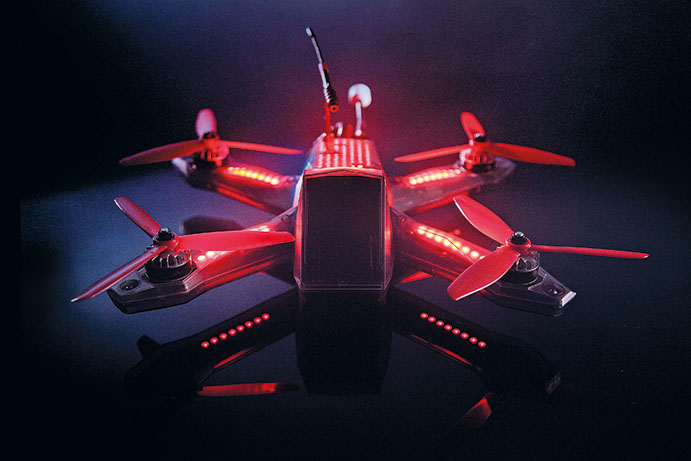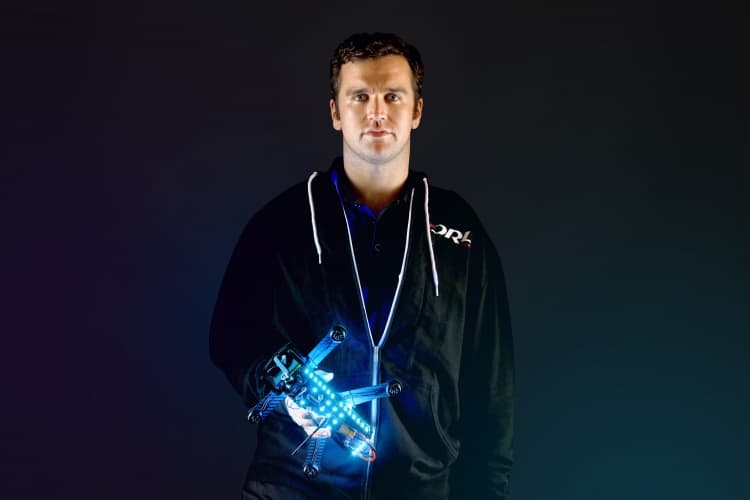At the vanguard of the fast-growing sport is the Drone Racing League (DRL), the second season of which is set to air soon on Sky Sports and ESPN. Pilots wearing first-person-view (FPV) goggles use radio controllers to fly small drones around themed 3D courses, reaching speeds approaching 100mph. Made from carbon fibre, the drones use high-performance electronic speed controllers that modulate the amount of power that goes to each of the four motors. This allows them to speed up or slow down extremely quickly, enabling jaw-dropping manoeuvres that resemble a live-action video game.

“We develop all of our drones in-house,” Nicholas Horbaczewski, DRL founder and CEO, told The Engineer. “We started, at the very beginning of the company, working on drone design to see if we could create the ultimate racer for a sport like this. It needs to balance incredible speed and performance with things that are necessary for a spectator sport, such as visibility and identifiability in the air.”
While all the drones are identical in spec, they have ultra-bright LEDs in different colours so that viewers can follow the action. Unlike commercial drones, the DRL models are built primarily for speed rather than stability, with pilots able to exert incredibly precise control. According to Horbaczewski, uniform equipment and a level playing field were fundamental for a number of reasons.
“It was important to make sure that when you saw a pilot win a race, you knew that was the best pilot, not necessarily the person flying a faster drone,” he said.
“I think the other reality is that we build over 500 drones for our races. When you consider there’s 12 pilots in every race, you would almost be asking every pilot to show up with 50 identical, hand-built drones.”
Over the course of a single race weekend, virtually all of those 500 drones will suffer damage, with many getting totalled during the helter-skelter action. The DRL then rebuilds the fleet between races, allowing it to constantly iterate. Horbaczewski said he could see the sport evolving to a point where pilots are backed by organisations that build their own drones – similar to how Formula One operates – but that type of paradigm is probably some way off.
For now, the only thing pilots need to worry about is going as fast as they can. Wearing the FPV headsets, they are fed a real-time HD video stream from a camera on the front of their drone. This is sent over a proprietary radio network infrastructure, which also facilitates the incredibly responsive controls required to navigate the intricate tracks.
“You need absolutely uninterrupted control uplink between the controllers and the drones,” Horbaczewski explained. “And then you need ultra-fast, low-latency video between the drone and the pilot’s goggles. When I say low latency, I mean well less than 60 milliseconds.”
That network needs to be built out over the complex 3D courses, which are generally several kilometres long, often incorporating hallways and tunnels. Tracks for the first season included the Miami Dolphins stadium and a disused shopping mall in LA. The 2017 season is set to culminate in a world championship decider at Alexandra Palace in June – a slight change in pace from the snooker and darts the venue is used to hosting.

Towards the mainstream
Allianz has already been signed up as the headline sponsor for the forthcoming season, and with major media partners also on board, it’s easy to imagine the sport gaining mainstream traction. While ESPN and Sky will broadcast the DRL, the league itself captures all the footage and edits it into packages ready for distribution. According to Horbaczewski, the speed of the action presents some unique challenges.
“We spent a long time before we even did our first event experimenting with techniques on how to film them,” he said. “I’d love to be able to say there’s one silver bullet that we came up with that solves it all, but, in reality, the solution is a thousand small decisions we’ve had to make.”
Those include everything from the type of cameras and lenses used, to the camera operators, camera positions, and the overall system used for capturing media. The breakneck pace of the action has also encouraged some innovative filming techniques, such as the use of ultra-high-speed cable cams that travel at 80-90mph, keeping up with the drones in full flight.

Red Bull makes hydrogen fuel cell play with AVL
Formula 1 is an anachronistic anomaly where its only cutting edge is in engine development. The rules prohibit any real innovation and there would be...